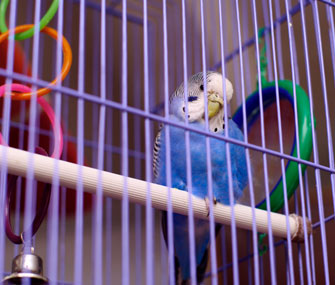How Can We Keep Our Bird Safe From Our Cat?
Published on March 04, 2013

Q. My cat constantly stalks our pet bird and acts like he’s ready to eat her for dinner. Can I do anything to change this situation?
A. Felines hunt birds not because they’re malicious, but because that’s what Mother Nature hardwired them to do. Stalking, pouncing and batting at prey are behaviors that even domesticated cats act out every day, in the form of chasing lights cast on the walls or playing with feather toys and mice. And while your cat may not have to catch his own dinner, he's still a born hunter, and his predatory behavior can transition from play to true predation when a live item of prey is conveniently located within the same household.
Cats, Birds and Stress
In the Looney Tunes cartoons, Tweety Bird doesn't really worry about being caught by Sylvester; he knows (as do we) that he willl escape. In real life, however, pet birds aren't always so sure of their safety, and they can become highly stressed when housed with cats who treat them as a potential meal. The psychological trauma of being stalked, swatted at and pounced on creates an unhealthy environment, even for a bird who is safely protected by a cage — after all, your bird doesn't know that the bars of the cage are going to stop your feline from getting her.
Stress can have various negative effects for birds, according to veterinary sources, including suppression of the immune system and changes in feather growth. Birds who are hunted inside a cage are put in a situation where every encounter with the cat simulates a life or death situation: The bird’s instincts tell it to flee, but the cage won’t allow it.
The threat isn’t only imagined either. Felines are skilled at batting at prey, and can work their paws through the bars of a cage, or swat at anything that happens to slip out, like a bird's tail feathers. Even a minor injury can turn into a life-threatening infection for your bird. There’s also danger of the cage being knocked over or the bird escaping when the cage is unlocked.
Create a Safe Space for Your Bird
Your cat and your bird should be separated in different areas of the home when the family is not present. When your family is at home, however, the cat and the bird will most likely do best in areas where people spend most of their time. Pet birds have social needs, and constantly isolating them in a secluded room can cause stress and can decrease their quality of life. Cats also need interaction, and keeping them shut away from the main living areas can cause anxiety. When people are home to supervise, it’s optimal to have both animals in areas where you and your family spend most of your time. It’s possible for the bird to be secluded in a closed room, such as a bedroom, as long as some members of your family are spending time in that room.
Most likely though, your cat and your bird will wind up sharing the same living space, which requires extra protection in the bird’s housing area. The bird cage should be secured up high, out of your cat’s reach or pounce range, and placed in an open spot away from anything the cat can climb. Any time the bird is taken out of her cage, the cat should be placed in a secure area, like a crate or another room (with the door closed).
You can also make the area around the birdcage less attractive to your cat. Felines dislike citrus smells; consider using citrus oil or peel as a nonharmful deterrent in areas around the bird’s housing. If your cat enjoys standing directly under the birdcage, cover that section of the floor with tin foil or an overturned doormat with the spiky traction side up. Both of these options will be uncomfortable for your cat to walk on.
Channel Your Cat's Predatory Urges
Provide your feline with ample opportunities to enact predatory behavior in a safe manner. During times when the cat and bird are together in the same room, direct your cat’s attention to interactive toys that expend physical and mental energy. Provide him with a variety of toys, such as play mice and feather toys or motorized toys simulating real prey. Food puzzles are another good way to redirect your cat’s interest and expend energy. You can also hide 10 percent of your cat’s daily food around the house to encourage investigation of his environment and distract him from hunting your bird.
Sometimes, however, it is impossible for cats and birds to peacefully coexist. In this situation, rehoming is the best solution for the mental and physical well-being of the bird. In many cases, though, simple environmental management is all it takes to ensure safe interactions between cat and bird.





